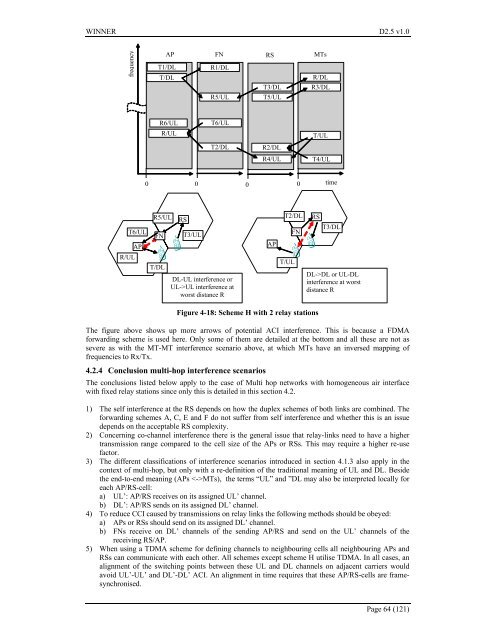IST-2003-507581 WINNER D2.5 v1.0 Duplex ... - Celtic-Plus
IST-2003-507581 WINNER D2.5 v1.0 Duplex ... - Celtic-Plus
IST-2003-507581 WINNER D2.5 v1.0 Duplex ... - Celtic-Plus
- No tags were found...
Create successful ePaper yourself
Turn your PDF publications into a flip-book with our unique Google optimized e-Paper software.
<strong>WINNER</strong> <strong>D2.5</strong> <strong>v1.0</strong>frequencyAP FN RSMTsT1/DLR1/DLT/DLR/DLT3/DL R3/DLR5/ULT5/ULR6/ULT6/ULR/ULT/ULT2/DLR2/DLR4/ULT4/UL0 000timeT6/ULAPR5/ULFNRST3/ULAPT2/DLFNRST3/DLR/ULT/DLDL-UL interference orUL->UL interference atworst distance RT/ULDL->DL or UL-DLinterference at worstdistance RFigure 4-18: Scheme H with 2 relay stationsThe figure above shows up more arrows of potential ACI interference. This is because a FDMAforwarding scheme is used here. Only some of them are detailed at the bottom and all these are not assevere as with the MT-MT interference scenario above, at which MTs have an inversed mapping offrequencies to Rx/Tx.4.2.4 Conclusion multi-hop interference scenariosThe conclusions listed below apply to the case of Multi hop networks with homogeneous air interfacewith fixed relay stations since only this is detailed in this section 4.2.1) The self interference at the RS depends on how the duplex schemes of both links are combined. Theforwarding schemes A, C, E and F do not suffer from self interference and whether this is an issuedepends on the acceptable RS complexity.2) Concerning co-channel interference there is the general issue that relay-links need to have a highertransmission range compared to the cell size of the APs or RSs. This may require a higher re-usefactor.3) The different classifications of interference scenarios introduced in section 4.1.3 also apply in thecontext of multi-hop, but only with a re-definition of the traditional meaning of UL and DL. Besidethe end-to-end meaning (APs MTs), the terms “UL” and ”DL may also be interpreted locally foreach AP/RS-cell:a) UL’: AP/RS receives on its assigned UL’ channel.b) DL’: AP/RS sends on its assigned DL’ channel.4) To reduce CCI caused by transmissions on relay links the following methods should be obeyed:a) APs or RSs should send on its assigned DL’ channel.b) FNs receive on DL’ channels of the sending AP/RS and send on the UL’ channels of thereceiving RS/AP.5) When using a TDMA scheme for defining channels to neighbouring cells all neighbouring APs andRSs can communicate with each other. All schemes except scheme H utilise TDMA. In all cases, analignment of the switching points between these UL and DL channels on adjacent carriers wouldavoid UL’-UL’ and DL’-DL’ ACI. An alignment in time requires that these AP/RS-cells are framesynchronised.Page 64 (121)
















